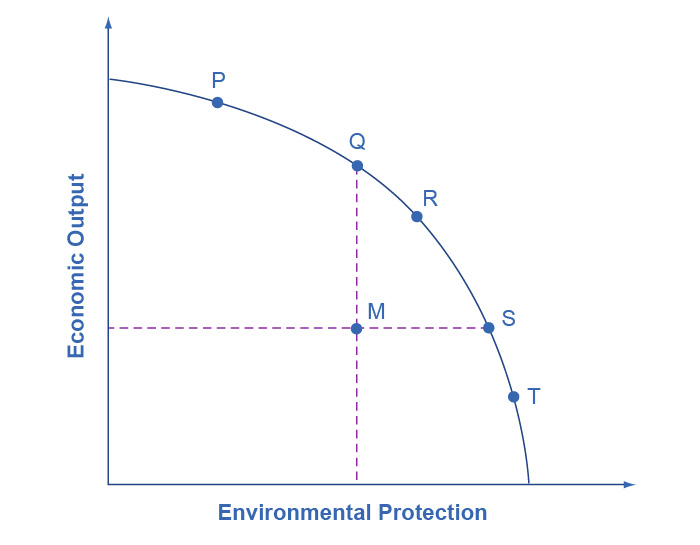92 The Tradeoff between Economic Output and Environmental Protection
Learning Objectives
By the end of this section, you will be able to:
- Apply the production possibility frontier to evaluate the tradeoff between economic output and the environment
- Interpret a graphic representation of the tradeoff between economic output and environment protection
We can analyze the tradeoff between economic output and the environment with a production possibility frontier (PPF) such as the one in Figure 12.5. At one extreme, at a choice like P, a country would be selecting a high level of economic output but very little environmental protection. At the other extreme, at a choice like T, a country would be selecting a high level of environmental protection but little economic output. According to the graph, an increase in environmental protection involves an opportunity cost of less economic output. No matter what their preferences, all societies should wish to avoid choices like M, which are productively inefficient. Efficiency requires that the choice should be on the production possibility frontier.
Figure 12.5 The Tradeoff between Economic Output and Environmental Protection Each society will have to weigh its own values and decide whether it prefers a choice like P with more economic output and less environmental protection, or a choice like T with more environmental protection and less economic output.
Economists do not have a great deal to say about the choice between P, Q, R, S and T in Figure 12.5, all of which lie along the production possibility frontier. Countries with low per capita gross domestic product (GDP), such as India, place a greater emphasis on economic output—which in turn helps to produce nutrition, shelter, health, education, and desirable consumer goods. Countries with higher income levels, where a greater share of people have access to the basic necessities of life, may be willing to place a relatively greater emphasis on environmental protection.
However, economists are united in their belief that an inefficient choice such as M is undesirable. Rather than choosing M, a nation could achieve either greater economic output with the same environmental protection, as at point Q, or greater environmental protection with the same level of output, as at point S. The problem with command-and-control environmental laws is that they sometimes involve a choice like M. Market-oriented environmental tools offer a mechanism for providing either the same environmental protection at lower cost, or providing a greater degree of environmental protection for the same cost.
Bring It Home
Keystone XL
How would an economist respond to claims of environmental damage caused by the Keystone XL project? Clearly, we can consider the environmental cost of oil spills a negative externality, but how large would these external costs be? Furthermore, are these costs “too high” when we measure them against any potential for economic benefit?
As this chapter indicates, in deciding whether pipeline construction is a good idea, an economist would want to know not only about the marginal benefits resulting from the additional pipeline construction, but also the potential marginal costs—and especially the pipeline’s marginal external costs. Typically these come in the form of environmental impact statements, which are usually required for such projects. For example, an impact statement, released in March 2013 by the Nebraska Department of State, considered the possibility of fewer pipeline miles going over the aquifer system and avoiding completely environmentally fragile areas. It indicated that pipeline construction would not harm “most resources”.
As noted at the outset of this chapter, the Obama Administration declined to approve construction of the Keystone XL project. However, the Trump administration announced its willingness to do so, but as noted earlier, the Biden administration effectively ended the project. While we may fairly easily quantify the economic benefits of additional oil in the United States, the social costs are more challenging to measure. Consequently, different observers may reach different conclusions about the balance between estimates of economic benefits and estimates of the social costs of the pipeline project.
Access for free at https://openstax.org/books/principles-economics-3e


